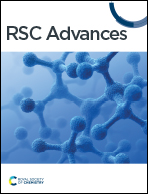Engineered rare-earth nanomaterials for fluorescence imaging and therapy†
Abstract
Early diagnosis and treatment are of great significance for hindering the progression of brain disease. The limited effects of available treatments and poor prognosis are currently the most pressing problems faced by clinicians and their patients. Therefore, developing new diagnosis and treatment programs for brain diseases is urgently needed. Near-infrared (NIR)-light-responsive, lanthanide-doped upconversion nanoparticles (UCNPs) provide great advantages both in diagnosis and therapy. Hence, we synthesised nanoparticles comprised of a UCNPs core with surface functionalization. UCNPs@Au was used for NIR fluorescence imaging in the brain and inhibiting the growth of mouse glioma 261 (GL261) cells depending on photothermal properties. In addition, a UCNPs core and a mesoporous silica layer as the outer shell with a tannic acid–Al3+ ions (TA–Al) complex as a “gatekeeper” were used for pH-triggered doxorubicin/small interfering ribonucleic acid delivery in vitro. Based on our preliminary results, we expect to develop more multifunctional nanoscale diagnostic and therapeutic agents based on UCNPs for the diagnosis and treatment of brain diseases, including Alzheimer's disease, Parkinson's disease, and brain tumours.



 Please wait while we load your content...
Please wait while we load your content...